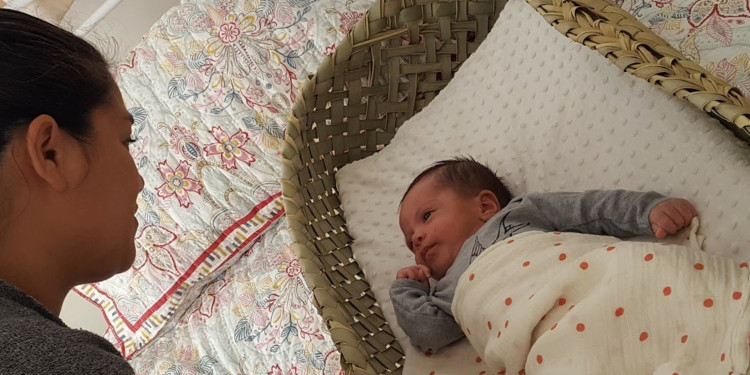Traditional Maori cradles prevent babies from dying suddenly
This special baby crib is called wahakura and has been used by Maori for a long time.
The cradle is woven from flax fiber, has centuries of history in New Zealand. Sleep experts believe that this type of cradle may be the new way to prevent dozens of sudden infant deaths in New Zealand each year.
Wahakura is a kind of baby cradle that has been created and used by the Maori natives of New Zealand since the 1600s to the present.
"In places with low medical levels, the sudden infant mortality rate is quite high," said the study's lead author, Associate Professor Sally Baddock.

A Maori mother watching a baby in a wahakura cradle weaves from flax.(Image source: The Huffington Post).
Sudden infant death syndrome, English name sudden infant death syndrome (SIDS), is the case of death that cannot explain the cause in children under 1 year of age.
According to statistics, in the United States more than 2,000 children died of unknown causes in 2010. 90% of sudden death children are in the age group under 6 months. Most SIDS occur in children under 1 year of age and occur quietly and unexpectedly even for children who seem to be very healthy.
Many scientists believe that findings related to the young brain cannot fully explain the cause of SIDS. Evidence suggests that there are still other issues involved and cause sudden death of children under 1 year of age.
There is a view that, if the following three factors occur, children can die: (1) Poor natural health; (2) The development process is difficult and conflicting; (3) Negative effects due to impacts from the external environment.
It is estimated that up to 50-85 cases of sudden infant death occur every year in New Zealand. Up to 62% of them are Maori children. Although Māori make up only 15% of the country's population.
Experts suspect, the cause of this phenomenon is due to the habit of sleeping with a newborn baby or smoking during pregnancy.
A group of local weavers developed and improved wahakura to better suit the modern environment, helping Maori mothers to sleep with their children while still ensuring their safety.
The wahakura crib is woven from native New Zealand flax , soft and flexible. So Maori mothers can put wahakura directly into their beds.

The wahakura crib is woven from native New Zealand flax, soft and flexible.
Scientists observed 200 Maori mothers with babies. Among them, 96 mothers use traditional cradles, the rest use wahakura cradles. They were interviewed about the quality of sleeping experience when using different types of baby cribs. Researchers have also installed infrared cameras to monitor newborn use and sleep patterns.
The results showed that babies sleeping on wahakura had better health because they were kept lying on their backs, and were not covered by clothes or other objects.
In addition, wahakura moms have twice as many breast-feeding rates as mothers who use normal cradles.
According to the US Food and Drug Administration, this is an act that could help reduce infant mortality. The American Academy of Pediatrics believes that placing babies on their backs to sleep also reduces the risk of SIDS.
- High-tech cribs can protect millions of poor children around the world
- New Zealanders have a great custom and meaning to protect nature
- 19 interesting facts about babies make adults suddenly fall back
- Will babies who breastfed out be better?
- Patents for children in the early 20th century
- Traditional Mediterranean meals help prevent diabetes
- My mother has H1N1 flu, my baby is dead easily
- Strangely, the girl could smell the smell of dying
- The principle that every adult must know to prevent kidnapping children
- Where does the child cry most?
- The secret of babies
- Miraculous abilities of babies
- Why shouldn't cow's milk be given to babies?
 Green tea cleans teeth better than mouthwash?
Green tea cleans teeth better than mouthwash? Death kiss: This is why you should not let anyone kiss your baby's lips
Death kiss: This is why you should not let anyone kiss your baby's lips What is salmonellosis?
What is salmonellosis? Caution should be exercised when using aloe vera through eating and drinking
Caution should be exercised when using aloe vera through eating and drinking